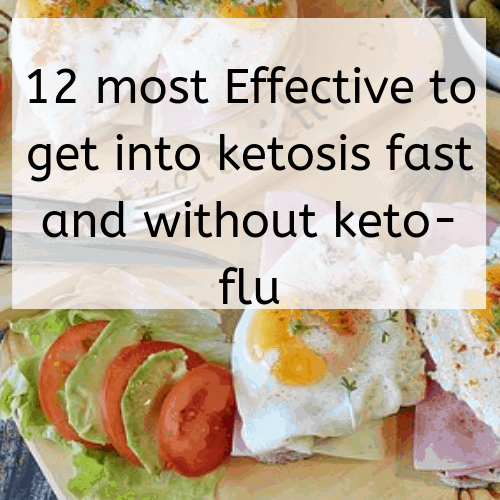You can get into ketosis in 24 hours which can help you with keto-flu-like symptoms that can be uncomfortable.
But you should know that everyone’s body is different. Different people will take different times to get into ketosis. But you can kick start ketosis by some hacks which we will discuss later.
In short, getting ketosis fast means the less painful transition will be.
I have done some research on how to get into ketosis very fast even in 24 hours. But, it is like a commitment to yourself, you have to stay strong.
Contents
- How much time does it take to get into ketosis?
- How to get into ketosis in 24 hours?
- 1. Minimize Carbs Intake As Low As Possible During the Transition
- 2. Eat Healthy Fat As Much You Can
- 3. Add a spoon of coconut oil to your diet
- 4. Eat Less Protein
- 5. Increase Your Physical Activity
- 6. Try Intermittent Fasting or Fasting In General
- 7. Try Fat Fasting
- 8. Drink A Lot Of Water
- 9. Maintain Proper Electrolyte Balance
- 10. Avoid Snacking
- 11. Try Exogenous Ketones
- 12. Adjust Your Diet With Ketones Level
- Is it safe to get into ketosis fast?
- Words, for you
How much time does it take to get into ketosis?
it takes 2-4 days to get into ketosis. But It takes a different amount of time to get into ketosis because everyone has a different metabolism, insulin resistance, and different carb tolerance.
Some people can get into ketosis within 24 hours and some can even take the whole week.
But you can kick start ketosis by some really useful hack.
How to get into ketosis in 24 hours?
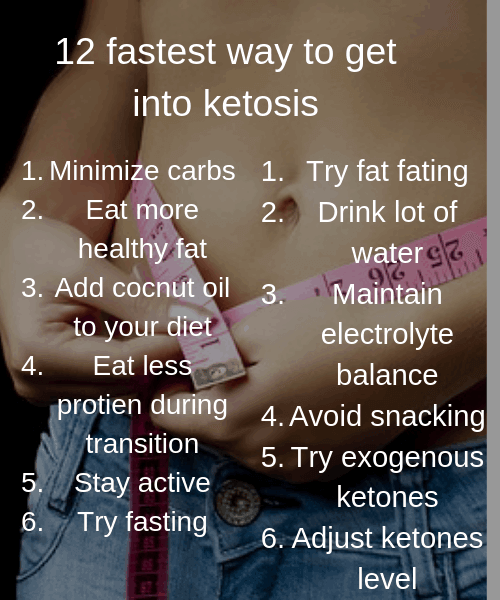
1. Minimize Carbs Intake As Low As Possible During the Transition
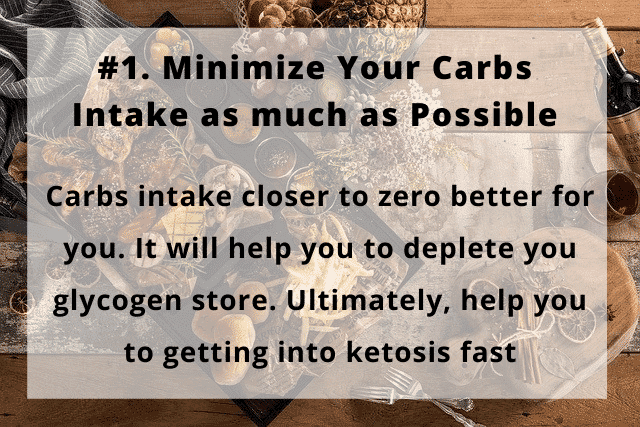
The amount of carbs you are taking is the most important factor to get into ketosis. Lower the carbs intake faster you get into ketosis, higher carbs intake slower the process is.
Normally carbs are the main source of energy. However, our body can use other fuel sources such as fatty acids.
Our body also stores glucose in the liver and muscles.
As glucose levels decrease our liver starts using these glycogen stores to maintain the glucose level. As this store runs out, your body starts using the fatty acid stores and you jump into ketosis.
So, minimize the carbs intake as this near to zero faster glycogen stores depleted and faster you get into ketosis.
Time to get into depends upon the individual some people get into ketosis fast and some can take a week.
Limit of carbs also depends on individuals some people need 20g or fewer carbs while others can eat twice to get into ketosis at the same time
This restriction is only for during the transition once you get into ketosis, start increasing carbs intake up to 50g (5-10%).
Once you are in ketosis, you can easily decrease or increase carbs intake as your carbs tolerance level.
For example, in a study with type 2 diabetes militias allowed to eat 20-50g carbs a day to maintain blood glucose target range of 0.5–3.0 mmol/L. [1]
While therapeutic ketogenic diets often restricted to fewer than 15g carbs. [2]
Conclusion
Try to eat low carb as much possible or stop eating any carbs completely. Lower the carb intake faster you will be getting into ketosis naturally.
2. Eat Healthy Fat As Much You Can
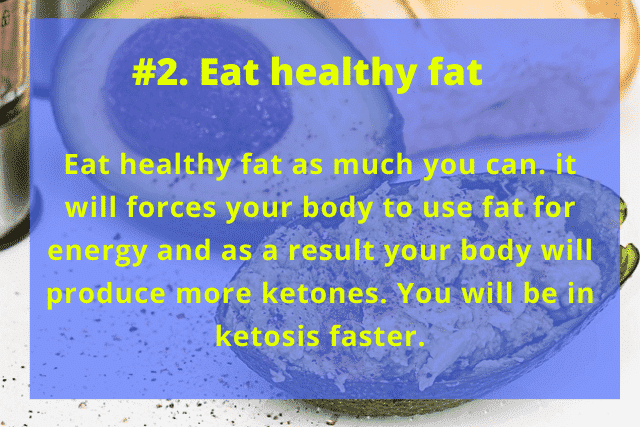
Eating healthy fat can also help your body to boost your blood ketone levels.
Minimizing carbs can help with minimizing the blood glucose level and eating more healthy fats will help you boost your ketone levels.
Eat more fat percentage-wise, not volume-wise. Your 90% calories should come from fat.
According to USSD, 1g of fat can give 9 calories and generally humans need 2000 calories a day.
So to get into ketosis fast, you should eat 175g to 200g fat so it can generate 1600 to 1800 calories.
Increasing fat intake doesn’t mean that you just start eating any random fat.
Your fat should be healthy fat. The ketogenic diet includes mostly fat. So, in general, you should also eat healthy and high-quality fat.
You can add these high-quality fats
- Olive oil
- Avocado oil
- Coconut oil
- MCT oil
- Fatty meat
- Butter
- Egg yolk
Conclusion
Eat more and more healthy fats. So, your body can easily use fat to produce ketone for energy
3. Add a spoon of coconut oil to your diet
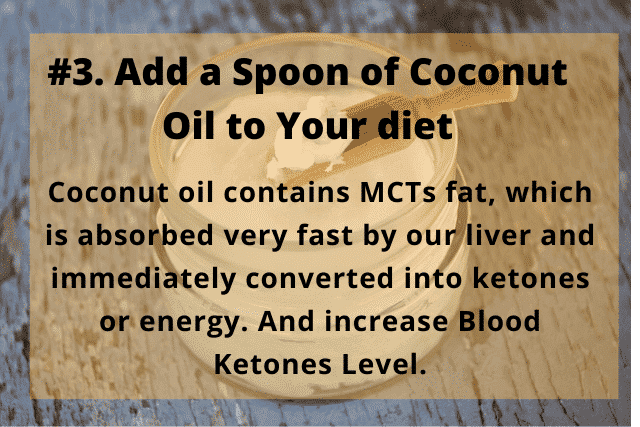
Coconut oil can help you to significantly increase your ketone level.
This is because coconut oil contains MCTs fat, which is absorbed very fast and our liver can immediately convert it into ketones or energy.
Coconut oil is also used to boost the ketones level in patients with neurodegenerative diseases. [3]
Coconut oil also contains lauric acid, which helps to sustain ketosis levels. Because it is metabolized gradually and maintain the ketone level. [4] [5] [6] [7] [8]
MCT oil can be out you into ketosis without decreasing the carbs drastically. [9] [10]
Coconut oil can help to minimize the symptoms of stomach cramping.
You can easily find these coconut oils at online stores.
Conclusion
MCTs oils are easy to break, these oils can be converted into energy immediately by our liver which boosts ketone production. Some parts of MCTs break gradually, which stable blood ketones level.
4. Eat Less Protein
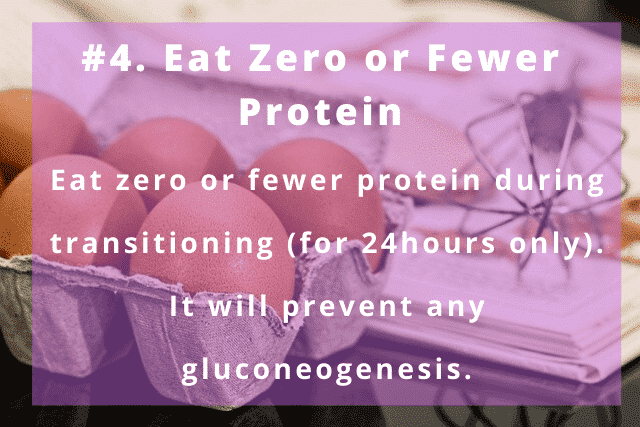
For a few days, this isn’t going to affect your muscle mass. This will help you to get over keto flu more quickly.
Too much protein can convert into glucose this is called gluconeogenesis. During this transition, you can eat less protein, even lesser than we usually take in ketosis.
Although cutting protein back isn’t healthy it can lead to muscle mass. But during the transition, which will take 24 to 48 hours, it can’t affect your health but, it will help you to get into ketosis faster.
Don’t cut back protein to zero, eat protein lesser than usual ketogenic diet during the transition only.
Because our liver needs protein to convert into glucose. Because our few organs can not use ketones as a fuel such as a portion of the brain, red blood cells, and some portion of the kidney.
Adequate protein in ketosis is necessary to maintain muscle mass during weight loss.
When you are in ketosis, you need 1.7 g per kg to maximize performance and to prevent muscle mass. [11]
Conclusion
Too much protein can convert into glucose this is called gluconeogenesis. Just cut back to protein as much as you can for the transition period only. Once you are comfortable with ketosis, you can increase accordingly.
5. Increase Your Physical Activity
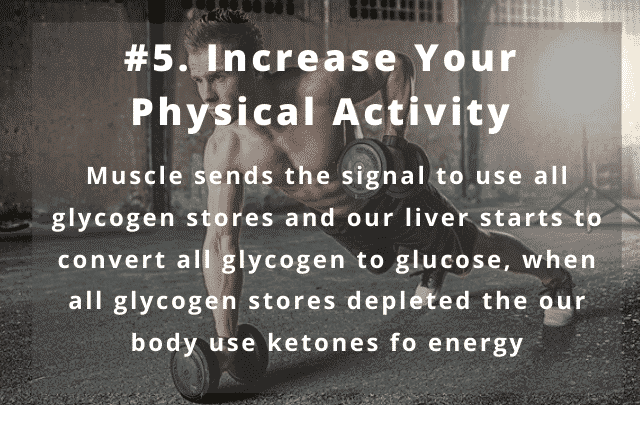
Increasing your physical activity can help you to get into ketosis faster.
Glycogen stores are in the liver and muscles. Liver glycogen can be used if you don’t eat anything and it will be depleted soon.
But muscle glycogen stores aren’t easily accessible to our liver. Muscle glycogen stores depleted only when muscles need energy.
When you exercise or increase your physical activity. Muscle sends the signal to use all glycogen stores and our liver starts to convert all glycogen to glucose.
Exercise will also help in the breakdown of glycogen to glucose. [13]
As you more engaged with exercise you will produce ketones faster.
Conclusion
Engage with physical exercises and deplete your glycogen stores faster. Deplete glycogen stores faster, start ketones production sooner and get into ketosis faster than ever.
6. Try Intermittent Fasting or Fasting In General
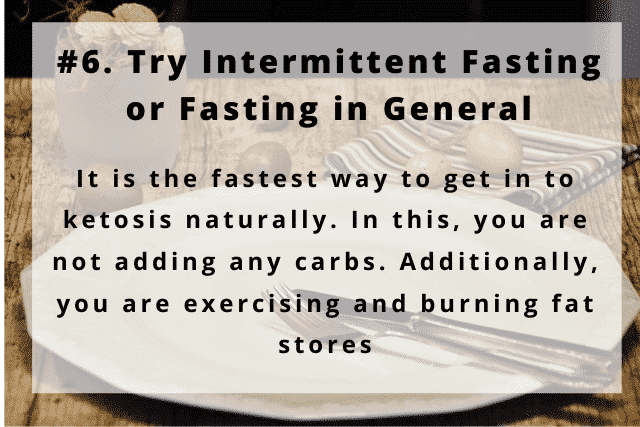
It can put some people in mild ketosis in breakfast to dinner on normal days.
During intermittent fasting, you will take only half the calories of your need (1000 in general).
Just think about that, the only thing that keeps you away from getting ketosis is carbs and glucose.
When you are fasting you are not taking any carbs during this period. Naturally, your body will use fat for energy. And it just forces your body into ketosis.
If you are fasting with exercising it will just ramp up your blood ketone level.
It is the fastest way to get into ketosis naturally. You are not adding any carbs and additionally, with exercising, you burn available glycogen stores too.
Conclusion
Fasting helps you to stop taking any carb and protein and ultimately your body will start using fat stores for energy.
7. Try Fat Fasting
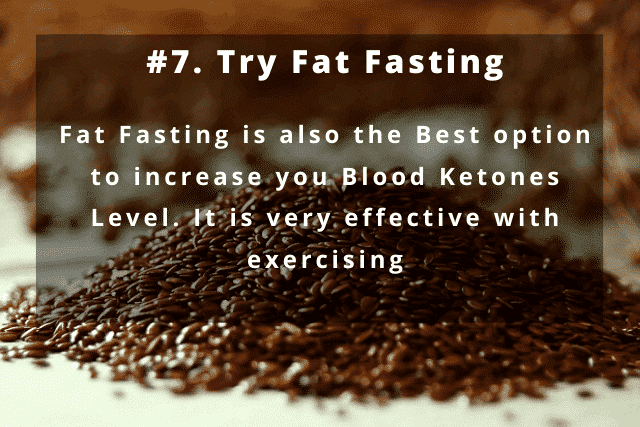
It’s just like fasting, but in fat fasting, you eat 1000 calories and more than 90% of calories come from fat. It can dramatically increase the blood ketone level.
Typically, about 70% of the calories come from fat in a keto diet.
You should not try fat fasting for more than 2-3 days. Come to your general keto diet after that.
You will eat about half of the calories (1000 calories) and about 90% of calories will come from fat.
So fat fasting is very effective in weight loss and it boosts your weight loss process.
Fat fast can really help if you want to get into ketosis fast.
Conclusion
Fasting help to stop taking any carb and protein and fat fasting add some healthy fat in it, to start producing ketones as soon as possible.
8. Drink A Lot Of Water
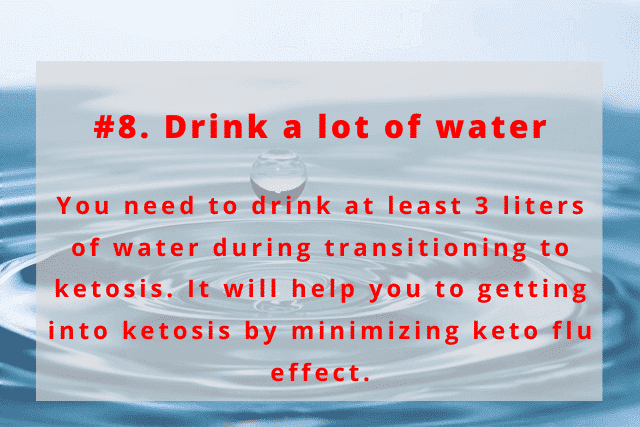
Proper water intake is very important during the ketogenic diet. Especially if your body is now during the adaptation stage.
Proper water intake can help you to get into ketosis by avoiding completely or minimum keto flu symptoms.
Water plays a vital role in the digestion and the elimination of toxins from your body.
Water helps metabolizes fat faster and proper kidney function. Although our bodies have some backup, it will take a little bit more time and we want ketosis very fast right.
A ketogenic diet dehydrates your body. This is why people lose most of their water weight during the first week. so you need more water than your normal diet.
You need to drink at least 3 liters of water during ketosis. When you are in ketosis, you can drink 2-3 liter water as you find comfortable.
The bottom line is you drink more water, you will metabolize fat faster, minimize keto flu symptoms and the kidney will function better.
Conclusion
Water reduces the keto-flu symptom and makes the ketosis process less painful. Drink about 3 liters of water a day during this time.
9. Maintain Proper Electrolyte Balance
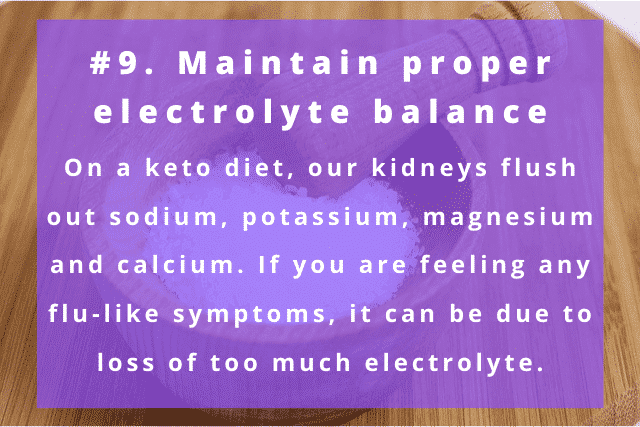
Maintaining proper electrolyte balance can also help with getting into ketosis by eliminating keto flu symptoms.
Electrolyte balance is necessary for proper body functioning. In fact, most of the keto flu symptoms are due to a lack of electrolytes.
In low carbs diet like the keto diet, our kidneys flush out sodium, potassium, magnesium calcium, etc [14]. If you are drinking more water you will flush more electrolytes.
You need more water but you also need electrolytes. So when you are on ketogenic diet drink water by mixing a pinch of salt in it.
If you are getting headaches, you need more salt. You will also need other electrolytes.
If you still feeling
- Tiredness
- Headaches
- Cramming
- Kidney pain
- Flu-like symptoms
Then you might need a supplementing dose of these electrolytes.
Conclusion
Most of the keto-flu symptoms are the result of electrolyte deficiency. The body flushes more electrolytes during this time. Maintain proper electrolytes to avoid keto-flu and to make ketosis journey enjoyable.
10. Avoid Snacking
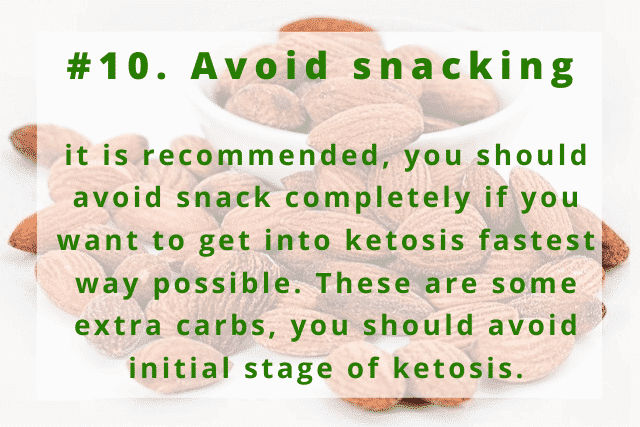
If you really want to get into ketosis fastest as possible. You need to avoid snacks.
You have to make sure that you are not eating anything unless you are hungry.
If you are snacking all-day blood sugar will never go down and you will be out of ketosis even you are trying everything else.
However, you can need snacks and you might be craving snacks. And outside the home, it can be very difficult to find keto-friendly foods.
You can buy keto-friendly snacks
- Keto Bars
- Keto Nut Butter
- Low-Sugar Beef Jerky
- Nuts and seeds
Although it is recommending that you should avoid snacks completely if you want to get into ketosis in the fastest way possible.
Conclusion
Although, out there tones of keto-friendly snacks, but you should avoid any snacking during initial stages of ketosis. Get into ketosis fastest as possible after that you can add more carbs to your diet according to your carb tolerance level.
11. Try Exogenous Ketones
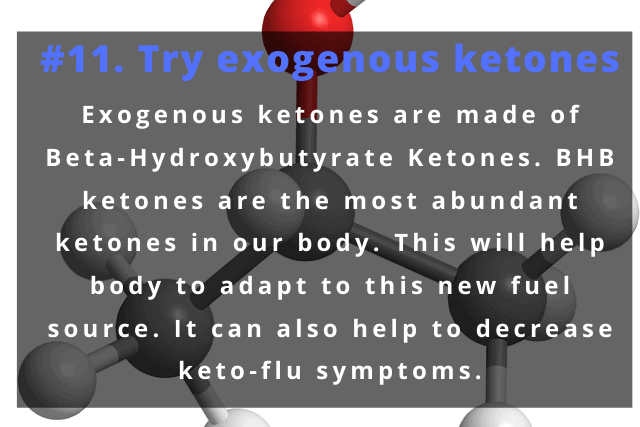
Exogenous ketones are made of BHB (beta-hydroxybutyrate) ketones. BHB ketones are the most abundant ketones in our body and it is a very efficient source of energy.
Exogenous ketones help your body to adapt to this new fuel source. It can also help to decrease keto-flu symptoms.
In fact, with exogenous ketones, you can get into ketosis fast and by avoiding keto-flu symptoms.
Conclusion
It will kick start your ketosis. These are the ready-made ketones, your body doesn’t have to make ketones from fat. Your body can instantly use these ketones for energy. Exogenous ketones are very effective in minimizing keto-flu symptoms.
12. Adjust Your Diet With Ketones Level
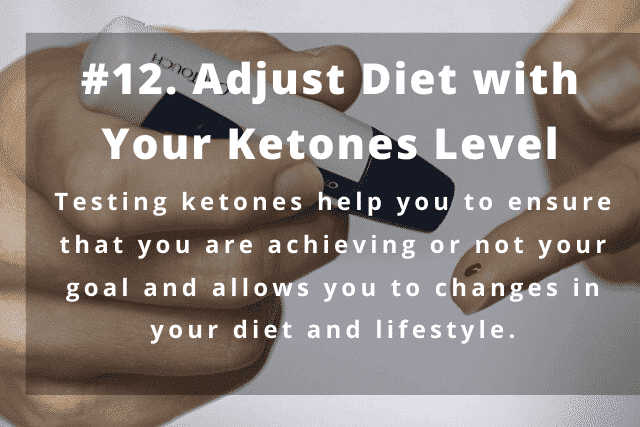
It is very necessary to test your ketones level to ensure that you are achieving your goals or not.
Check ketones level and adjust your diet according to this.
You can measure ketones in your blood, breath, and urine.
Acetone found in your breath and it is also a reliable method to measure ketones. [15]
The ketone breath analyzer meter can easily test your ketone level and it is very easy to use.
The ketone can be measured in your blood. It is also a very accurate method to measure ketones. [16]
because it measures BHB which most abundant acid in ketones. But it is very expensive to measure ketones in your blood.
The last method to measure is a urine test.
Acetoacetate is present in urine. But it is not considered as accurate as other methods. In this urine, drops are dropped on ketone urine strips, and its changes, its color depending on ketone level. The darker the color higher the ketones.
Testing ketones help you to ensure that you are achieving or not your goal and allows you to changes in your diet and lifestyle.
Conclusion
Check your blood ketones level, time to time. If your ketones level isn’t high, made changes to your diet.
Is it safe to get into ketosis fast?
Ketosis is a metabolic state that can be achieved when you stop eating carbs. Our body seeking out for new energy source and use fat to produce ketones for energy.
Ketosis is safe if you are a normal person with no medical condition.
If you are a person with medical conditions such as type 1 or type 2 diabetes. You should always ask your doctor before even restricting carbs.
Some people get into ketosis fast without even suffering keto flu symptoms and some can people take a longer time to get into ketosis followed by keto-flu symptoms which make it very difficult to follow a keto diet for some people.
Although these symptoms relieved after a few days by themselves.
If you ask in general is ketosis in 24 hours safe? Yes, it is safe. You can try all these hacks to get into ketosis in 24 hours.
Although there are some dangers of ketosis and you should know before trying all these hacks and getting into ketosis.
Words, for you
Getting ketosis in 24 hours is not easy. You should not stress out if you can not get into ketosis in 24 hours.
Everyone’s body is different with different metabolism. So, it will take different time to get into ketosis.
Make a proper diet plan for at least 3 days and follow it strictly.
Try an exogenous supplement if it takes longer to get into ketosis for you.
General FAQs
How can I get into ketosis quickly?
Minimize carbs, increase healthy fat, add (MCTs) to food, stay active, empty glycogen stores, try fasting, stay hydrated, maintain electrolyte balance, if still having trouble then try exogenous ketones. These are the fastest way to get into ketosis.
How long does it take to get into ketosis?
It depends on individuals body. Some can get into ketosis in 24 hours and for some it can take more than one week. But, generally it takes 2-4 days to get into ketosis if you are just eating fewer than 50g carbs.
How do you know you’re in ketosis?
You will have bad breath, start losing weight, blood ketones more than 0.5–3.0 mmol/L, appetite supression, better focus, increased energy, etc.
What foods keep you in ketosis?
Foods high in fats and low in carbs will keep you in ketosis. So, always take less than 5-10% calories from carbs and more than 60% calories from fat.
Sources
Healthline “https://www.healthline.com/nutrition/7-tips-to-get-into-ketosis”
MedicalNewsToday “https://www.medicalnewstoday.com/articles/324599.php”
NCBI “https://www.ncbi.nlm.nih.gov/pmc/articles/PMC4313585/”
NCBI “https://www.ncbi.nlm.nih.gov/pubmed/22840388”
NCBI “https://www.ncbi.nlm.nih.gov/pubmed/25997382”
NCBI “https://www.ncbi.nlm.nih.gov/pmc/articles/PMC524027/”
NCBI “https://www.ncbi.nlm.nih.gov/pmc/articles/PMC3784189/”
